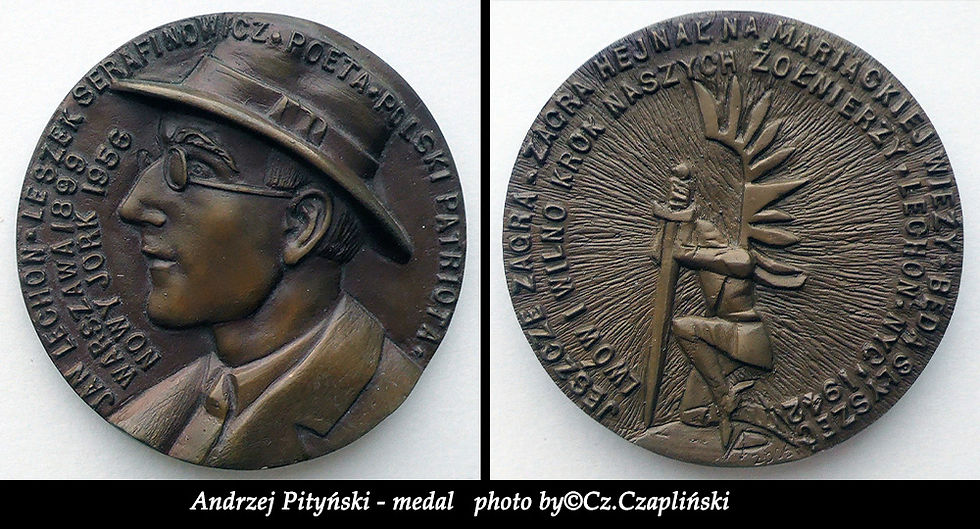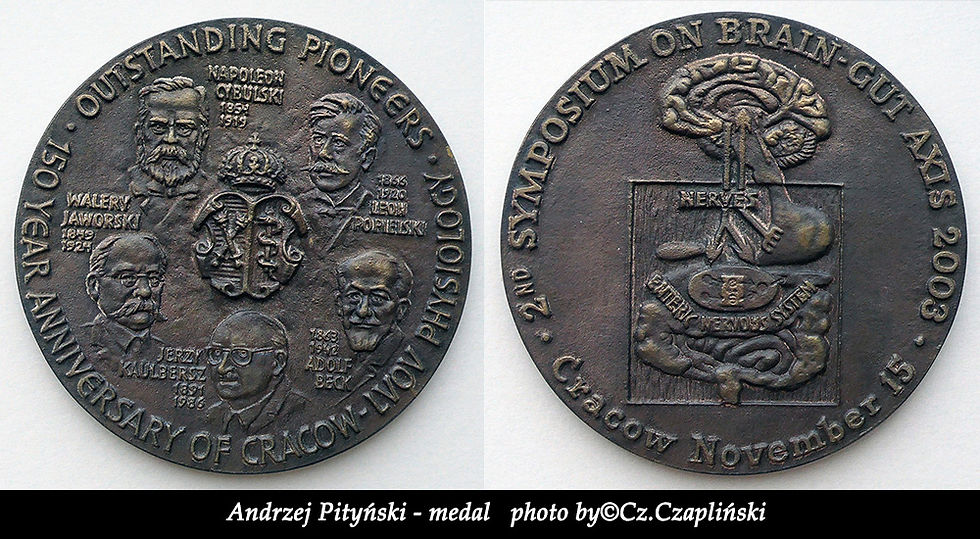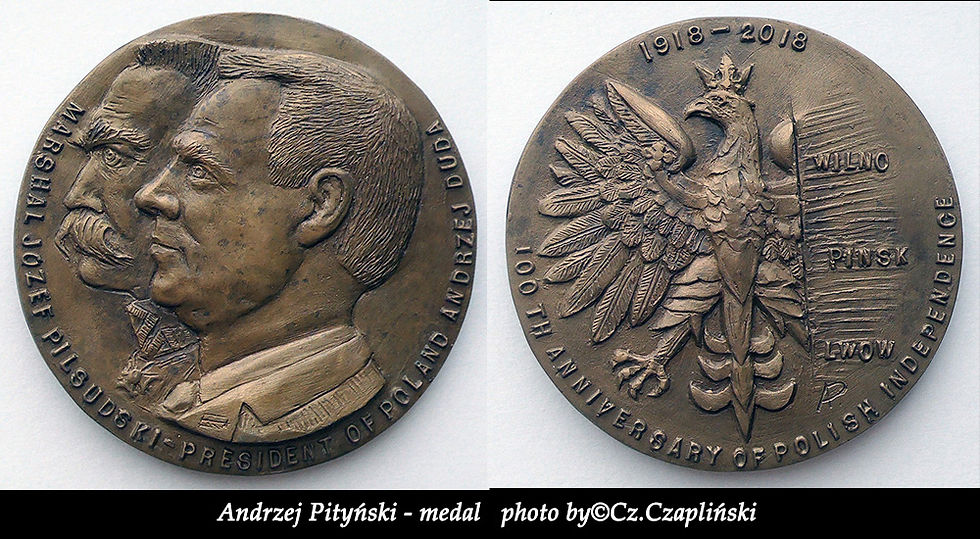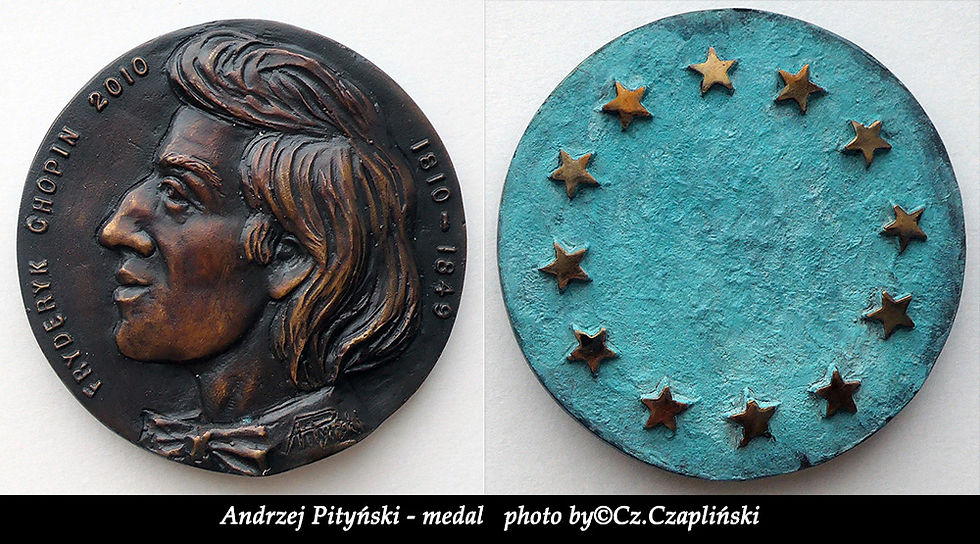PORTRET z HISTORIĄ Andrzej Pityński
- Czesław Czapliński

- 9 sty 2020
- 13 minut(y) czytania
Zaktualizowano: 15 lip

„…Pomniki przemawiają symbolem. Dobry pomnik, oglądany nawet przez kilka minut, pamięta się przez długie lata lub całe życie. Pomniki są jak słupy milowe w historii narodów — nie pozwalają innym systemom i ustrojom zniszczyć waloru i rdzenia kultury narodowej…” – Andrzej Pityński.
Z Andrzejem Pityńskim przyjaźniłem się od 1980 r., czyli samego mojego początku w Nowym Jorku. Zrobiliśmy kilka wspólnych projektów, pisałem i fotografowałem wszystkie jego pomniki w Ameryce i w Polsce. Powstało kilka katalogów i wystaw jego prac, niedawno skończyłem o nim film dokumentalny, który zaczyna się wręczeniem Pityńskiemu przez Prezydenta, najwyższego odznaczenia w Polsce Orderu Orła Białego.
Pityński w Stanach Zjednoczonych cieszył się sławą wybitnego twórcy rzeźby pomnikowej i należał do elitarnego National Sculpture Society (NSS).

Jego artystyczne dokonania zostały wyróżnione w albumie „Mistrzowie amerykańskiej rzeźby” oraz w leksykonie „Kto jest kim w amerykańskiej rzeźbie”. W 2001 r. znalazł się wśród ośmiu artystów wybranych przez specjalną komisję NSS do zaprezentowania swych prac podczas corocznej prestiżowej wystawy „Sculpture from New Yorker's Studios”. Przez ponad trzydzieści lat pracował i wykłada w Johnson Atelier Technical Institute of Scalpture w Mercerville w stanie New Jersey.


Andrzej Pityński (ur. 15 marca 1947 r. w Ulanowie, niewielkim miasteczku położonym w widłach Sanu i Tanwi na podkarpaciu, dawnej stolicy flisactwa, zm. 18 września 2020 r. w Mount Holy, NJ, USA). Jego dziadek Andrzej Marcin Pityński (1902-1982) był retmanem, czyli przywódcą transportu, kilku połączonych tratw, gdzie na początku XX wieku, spławiano drewno Sanem i Wisłą, aż do Gdańska.
Rodzice Andrzeja Pityńskiego – ojciec Aleksander (1926-1994) i mama Stefania (1925-1997) poznali się podczas okupacji niemieckiej, jako partyzanci AK-NOW, walczący jeszcze długo po zakończeniu wojny, o wolną Polskę. Jego wuj Michał Krupa „Pułkownik” (1920-1972) — którego młody Andrzej odwiedzał w leśnych kryjówkach — zdradzony i osaczony przez UB, MO, ZOMO został aresztowany 19 lutego 1959 r. w Kulnie k.Leżajska, jako jeden z ostatnich partyzantów w Polsce po II wojnie światowej. Dziadek Pityńskiego były retman i ułan, wpoił wnukowi miłość do koni, który po latach wspomina: „Mam dwie pasje – rzeźbę i konie. Łącze je ze sobą. Moim ulubionym tematem jest jeździec i koń. Rzeźbiąc, staram się wyrazić ideę ruchu konia i jeźdźca, harmonię scalenia dwóch istot żywych w jedną bryłę. Kto nie przeżył zmagań z naturą, nie przebył setek kilometrów w siodle, karkołomnych upadków, niebezpiecznych sytuacji, w których jeździec i koń pomagają sobie, ufają i wierzą wzajemnie, ten nigdy mnie nie zrozumie...”.
W krakowskiej ASP Pityński studiował w latach 1968-1974 na wydziale rzeźby u prof. M. Koniecznego i J. Bandury. Jeszcze przed dyplomem zrealizował pierwsze prace: pomnik Ignacego Paderewskiego stojący przed Collegium Padarevianum w Krakowie, płaskorzeźbę królowej Jadwigi i rzeźbę „Kircholm”.

Fascynacja koniem trwa, Pityński bierze udział w zawodach jeździeckich, występuje na koniu w filmie „Czarne chmury”, jego dyplom na krakowskiej ASP zatytułowany był „Jeździec i koń – autobiografia” w pracowni prof. Jerzego Bandury, który wspominał po latach swego ucznia: „…Andrzej Pityński przyjechał do Krakowa nieśmiale uśmiechnięty, nie wiem jakim cudem przebrnął przez maszynkę egzaminu wstępnego — nic nie umiał. W jego domowych szkicownikach widziało się napady na dyliżans, podobizny szeryfów itd. Zaczął od zera... Mówił głównie o koniach, a w szkole „brał przeszkody” — ulubione jego powiedzonko…”.
Pityński po latach przyznaje, że najwięcej zawdzięcza swojemu mistrzowi Bandurz, któremu do dziś brzmią w uszach słowa profesora, cytującego Matejkę: „Sztuki od miłości ojczyzny oderwać nie wolno”, czy też „Rzeźbiarz bez natchnienia, bez pasji twórczej, jest jak samochód wyścigowy bez benzyny”.
W 1974 r. wyjechał do Stanów Zjednoczonych. Rozpoczynał od prac na budowach i jednocześnie chodził na kursy w Arts Students League w Nowym Jorku. Jego zawodowa kariera rozpoczęła się w Sculpture House na Manhattanie, gdzie poznał techniki odlewów w brązie i powiększania pomników. Już w 1975 r. został asystentem A. Ettle’a – nestora amerykańskiej rzeźby. Dzięki jego rekomendacji znalazł się w Johnson Atelier –Technical Institute of Sculpture, a po kilku latach został dyrektorem czterech wydziałów modelowania artystycznego (powiększanie pomników, odlewnictwa, komponowania brył przestrzennych).
Kolejna artystyczna droga Pityńskiego rozpoczęła się od rzeźby Artura Rubinsteina. Dziś wśród zrealizowanych projektów szczególne miejsce zajmują pomniki: Partyzanci (Boston, 1983); Marii Curie-Skłodowskiej (Bayonne, 1987); „Sarmata” (Morris Museum); Jerzego Popiełuszki (Trenton, 1987); Papieża Jana Pawła II (Manhattan i Ulanów, 1989); „Mściciel” (Doylestown, Pensylwania; Amerykańska Częstochowa, 1988); „Katyń 1940” (Jersey City, 1991), „Pomnik Błękitnej Armii” (Warszawa, 2002).

Znalazłem się z Pityńskim w Ulanowie koło Stalowej Woli, na szczelnie wypełnionym rynku i przyległych ulicach, zgromadziło się ponad 15 tysięcy ludzi. Uroczystość odsłonięcia, poświęcenia i przekazania przez artystę-rzeźbiarza z Nowego Jorku pomnika Jana Pawła Il rozpoczęła się w niedzielę 20 sierpnia 1989 r. o godz. 11:00, procesją z kościoła parafialnego. Monumentalne popiersie Papieża w brązie o wysokości 1.5 m i wadze 300 kg ustawione na cokole z polerowanego granitu o wysokości 2 m i wadze 6 ton na środku rynku przykuwa uwagę. Po zbliżeniu się do pomnika oprócz widocznego z daleka ekspresyjnego popiersia, dostrzec można liczne płaskorzeźby. Od strony frontowej, po prawej stronie stuły Papieża wizerunek Matki Boskiej Częstochowskiej, a pod nią herb papieski, po lewej wizerunek św. Barbary, patronki flisaków i herb Ulanowa. Po bokach fragmenty nadania praw miejskich przez króla Zygmunta Il Wazę (1616 r.) i akt erekcyjny nadany przez magnata ziemi przemyskiej Stanisława Ulinę Ulińskiego (1618 r.). Z tyłu na szatach liturgicznych, w które przybrany jest Papież, płaskorzeźba — płynące tratwy ulanowskich flisaków, na czele retman w łodzi, wśród wianków i zapalonych świec.
Trzeba tu dodać, że pomnik JPII Pityński postawił bez zgody władz, które groziły mu aresztowaniem i nie wypuszczeniem do USA. Pamiętam to, był to w końcu 1989 r., mimo paszportu amerykańskiego można było mieć problemy.

— Jesteś sprawcą tego wydarzenia, twórcą i fundatorem pomnika Jana Pawła Il, pierwszego w Polsce pomnika Papieża w miejscu publicznym, nie na terenie kościelnym. Co skłoniło cię do zrobienia dla Ulanowa pomnika, który pochłonął kilkadziesiąt tysięcy dolarów twoich oszczędności (odlew w brązie, granitowy postument, transport do Polski), nie licząc wielu miesięcy pracy?

— Jakie są twoje wrażenia po 15 latach nieobecności w Polsce?
— Kiedy w lipcu i sierpniu 1989 r. odwiedziłem Polskę trafiłem na historyczne chwile: wizyta prezydenta Busha, wybór nowego premiera i rządu, odsłonięcie pomnika-epitafium dla dowódców AK na Powązkach, odsłonięcie kontrowersyjnego Pomnika Powstania Warszawskiego. Pobyt mój w Polsce trudno nazwać wypoczynkowym, a taki miał być. Najbardziej wyczerpywały wywiady dla prasy, radia i tv rządowej i solidarnościowej. W przeciągu kilku dni próbowałem nadrobić 15 lat. Bardzo mile wspominam prywatną wizytę u Prymasa Polski Józefa Glempa.

Ze zdziwieniem natomiast stwierdziłem, że moi koledzy z okresu studiów, którzy w czasie mego wyjazdu (1974 r.) pływali na komunistycznej fali, teraz pływają na fali Solidarności, teraz są antykomunistami i mówią o tym bez żenady. Kameleony czy ludzie bez charakteru?

Drugą rozmowę z Andrzejem Pityńskim odbyłem 19 maja 1991 roku, już w Jersey City/USA, przed odsłonięciem „Pomnika Katyńskiego” o którym Pityński mówił: „Głównym elementem pomnika jest kompozycja w brązie, przedstawiająca młodego, silnego mężczyznę, oficera Wojska Polskiego ze skrępowanymi do tyłu rękami, z zakneblowanymi ustami, w poszarpanym mundurze, w rogatywce z orłem w koronie, w bryczesach i wysokich butach oficerskich z ostrogami, krzyżem Virtuti Militari na piersi, przebitego od tyłu na wylot bagnetem sowieckiego karabinu. Myślę, że moja kompozycja ma coś z ukrzyżowania Chrystusa. Jest nie tylko symbolem mordu Katyńskiego, ale odradzającej się Polski po latach zaborów, która padła pod zdradzieckim, podstępnym ciosem w plecy 17 września 1939 r. Jest to symbol nie tylko śmierci młodego oficera, lecz również zagłady młodego polskiego pokolenia. Skutek haniebnego paktu dwóch zbrodniarzy — Hitlera i Stalina, sojuszu dwóch ideologii — faszyzmu i komunizmu. Katyń to epizod, to „klucz” dla międzynarodowej opinii publicznej, dzięki któremu można poznać prawdę o gehennie polskiego narodu, jaką zgotowała jej cywilizacja XX wieku, a skutki której trwają do dziś. Oprócz tego na wypolerowanej frontowej części cokołu umieszczony będzie polski orzeł wojskowy, we wnętrzu którego znajdą się prochy i ziemia z Katynia”.
Z broszury dowiaduję się, że „Pomnik Katyński" realizowany jest przez Społeczny Komitet Budowy", na czele którego stoją: J.Płoński, K.Nowak, S.Paszul, L.Rutkowski W.Sosulski, a w składzie honorowego komitetu widzę takie nazwiska jak: Lt. General Edward l. Rowny, Major General Jan. K. Krępa, prof. Zbigniew Brzeziński.

19 maja 1991 roku o godzinie 13.00 na Exchange Place Plaza w Jersey City, nad rzeką Hudson, tuż przy stacji metra, którym za pięć minut znaleźć się można w sercu Manhattanu, w tle z zapierającą dech w piersiach panoramą Nowego Jorku odsłonięto pomnik „Katyń 1940”. Pomnik jest odlany z brązu i razem z granitowym postumentem ważącym 60 ton ma 11 metrów wysokości. Jest pierwszym w Ameryce pomnikiem poświęconym polskim ofiarom sowieckiego komunizmu.
Na wypolerowanym froncie granitowego cokołu umieszczono urnę w formie płaskorzeźby przedstawiającej orła wojskowego w koronie. Pod orłem wykuty napis „KATYŃ 1940”.
Lokalizacja pomnika „Katyń 1940” z widokiem na panoramę Manhattanu, jest jedną z najlepszych. Pamiętam zdjęcia z 1993 r. kiedy był atak na WTC, są zdjęcia, gdzie na pierwszym planie jest pomnik Pityńskiego, a w dali płonące WTC. Taka lokalizacja, to marzenie dla rzeźbiarza.

PORTRAIT with HISTORY Andrzej Pitynski
"... Monuments speak with a symbol. A good monument, viewed even for a few minutes, is remembered for many years or a lifetime. Monuments are like milestones in the history of nations - they do not allow other systems and systems to destroy the value and core of national culture ... "- Andrzej Pityński. I have been friends with Andrzej Pityński since 1980, i.e. my very beginning in New York. We made several joint projects, I wrote and photographed all his monuments in America and Poland. Several catalogs and exhibitions of his works have been created, I recently finished a documentary about him, which begins with the handing of the Order of the White Eagle to Poland by Pityński by the President. Pityński in the United States enjoys the fame of an outstanding creator of monument sculpture and belongs to the elite National Sculpture Society (NSS). His artistic achievements were honored in the album "Masters of American Sculpture" and in the lexicon "Who's Who in American sculpture ". In 2001, he was among eight artists selected by a special NSS commission to present their work at the annual prestigious exhibition 'Sculpture from New Yorker's Studios'. For over thirty years, he has worked and lectured at the Johnson Atelier Technical Institute of Scalpture in Mercerville, New Jersey. Born on March 15, 1947 in Ulanów, a small town located at the forks of San and Tanwia in the Podkarpackie Voivodship, the former rafting capital. His grandfather Andrzej Marcin Pityński (1902-1982) was a retman, i.e. the leader of transport, several connected rafts, where at the beginning of the 20th century, wood was floated along the San and Vistula, up to Gdańsk.
Andrzej Pityński's parents - father Aleksander (1926-1994) and mother Stefania (1925-1997) met during the German occupation as AK-NOW guerrillas, fighting long after the war for free Poland. His uncle Michał Krupa "Pułkownik" (1920-1972) - whom young Andrzej visited in the forest hideouts - betrayed and cornered by UB, MO, ZOMO, was arrested on February 19, 1959 in Kulno near Leżajsk, as one of the last partisans in Poland after World War II. Pityński's grandfather, a former retman and uhlan, instilled in his grandson a love for horses, who after years recalls: "I have two passions - sculpture and horses. I connect them together. My favorite subject is rider and horse. When carving, I try to express the idea of horse and rider movement, the harmony of merging two living beings into one block. Whoever did not survive the struggle with nature, did not travel hundreds of kilometers in the saddle, breakneck falls, dangerous situations in which the rider and horse help each other, trust and believe each other, he will never understand me ... ". In the Krakow Academy of Fine Arts Pityński studied in the years 1968-1974 at the sculpture department with prof. M. Koniecznego and J. Bandura. Even before graduating, he completed his first work: a monument of Ignacy Paderewski standing in front of the Collegium Padarevianum in Krakow, a relief of Queen Jadwiga and the sculpture "Kircholm". The fascination with the horse continues, Pityński participates in equestrian competitions, performs on horseback in the film "Black Clouds", his diploma at the Krakow Academy of Fine Arts was entitled "Rider and horse - autobiography" in the studio of prof. Jerzy Bandura, who he recalled after years of his student: "... Andrzej Pityński came to Krakow uneasyly smiling, I do not know how he got through the machine of the entrance examination - he could do nothing. His home sketchbooks saw attacks on the stagecoach, images of sheriffs, etc. He started from scratch ... He talked mainly about horses, and at school "he took obstacles" - his favorite saying ... ".

Years later, Pityński admits that he owes the most to his master Bandurz, who still has the words of a professor quoting Matejko in his ears: "You cannot take art away from the love of the homeland", or "A sculptor without inspiration, without creative passion, is like a race car without petrol. "
In 1974 he went to the United States. He started work at construction sites and at the same time attended courses at the Arts Students League in New York. His professional career began at the Sculpture House in Manhattan, where he learned bronze casting techniques and monument enlargement. Already in 1975 he became an assistant to A. Ettle - a nestor of American sculpture. Thanks to his recommendation, he found himself in the Johnson Atelier - Technical Institute of Sculpture, and after a few years he became the director of four departments of artistic modeling (enlarging monuments, foundry, composing spatial solids).

Pityński's next artistic path began with a sculpture by Artur Rubinstein. Today, among the completed projects, monuments occupy a special place: Partisans (Boston, 1983); Maria Curie-Skłodowska (Bayonne, 1987); "Sarmata" (Morris Museum); Jerzy Popiełuszko (Trenton, 1987); Pope John Paul II (Manhattan and Ulanów, 1989); "The Avenger" (Doylestown, Pennsylvania; American Częstochowa, 1988); "Katyn 1940" (Jersey City, 1991), "Monument of the Blue Army" (Warsaw, 2002).
I found myself with Pityński in Ulanów near Stalowa Wola, in a tightly filled market square and adjacent streets, over 15,000 people gathered. The ceremony of unveiling, dedication and handing over of the John Paul Il monument to the sculptor from New York began on Sunday, August 20, 1989 at 11:00, procession from the parish church. A monumental bust of the Pope in bronze 1.5 m high and weighing 300 kg set on a pedestal of polished granite 2 m high and weighing 6 tons in the middle of the market attracts attention. After approaching the monument, in addition to the bust visible from afar, you can see numerous reliefs. From the front side, on the right side of the Pope's stole, the image of Our Lady of Częstochowa, and under it the papal coat of arms, on the left, the image of Saint. Barbara, patron of rafters and the coat of arms of Ulanów. On the sides, fragments of granting city rights by King Zygmunt Il Waza (1616) and the foundation act granted by the magnate of Przemyśl, Stanisław Ulina Uliński (1618). In the back, on liturgical vestments in which the Pope is dressed, a bas-relief - flowing rafts of Ulan rafters, headed by a retman in a boat, among wreaths and lit candles.

It should be added that the monument to JPII Pityński was erected without the consent of the authorities, which threatened him with arrest and not being released to the USA. I remember it, it was at the end of 1989, despite the American passport, you could have problems.
- You are the perpetrator of this event, the creator and founder of the monument to John Paul Il, the first monument to the Pope in Poland in a public place, not in the church. What prompted you to do a monument for Ulanów, which consumed tens of thousands of dollars of your savings (bronze cast, granite pedestal, transport to Poland), not counting many months of work?
"I come from Ulanów," Pityński began, "from a family of rafters from the" Water Dukes "family, as the old Rethman families were called. Tradition says that after a long rafting (spring, summer, autumn), rafters returned to "Little Gdansk" as Ulanów was called, with rich gifts for the whole family and a thanksgiving for Saint. Barbara, patron of rafters from Ulanów. These gifts in the form of votive offerings made of silver, gold, beads and amber bought in Gdańsk were hung on the altar in the 16th-century rafting church in Ulanów. Returning home, after 15 years of separation, I decided to honor and pay homage to the noblest son of the Polish nation, his ideas. As well as a tribute to my homeland and this piece of Polish Earth, where I was born and raised, the city and its age culture. And finally my family, the roots from which I grew up. I would like this monument to be a proof for my countrymen that they want to be able to give them courage, patience, encouragement and self-denial in realizing their wildest plans and dreams. That, like our forefathers, they would not be afraid of great adventures, long journeys, hard work and that they would always be proud of Ulanów, an ancient settlement of romantic rafters.
—What are your impressions after 15 years of absence from Poland?
— When in July and August 1989 I visited Poland I came across historical moments: the visit of President Bush, the election of a new prime minister and government, the unveiling of the monument-epitaph for the Home Army commanders in Powązki, the unveiling of the controversial Monument to the Warsaw Uprising. My stay in Poland is difficult to call a recreational one, and it was meant to be. The most exhausted interviews for government and solidarity press, radio and TV. Within a few days I tried to make up for 15 years. I very much remember the private visit to the Primate of Poland Józef Glemp.
On the other hand, I was surprised to find that my classmates who were on the communist wave during my trip (1974) are now sailing on the Solidarity wave, now they are anti-communists and they say it without embarrassment. Chameleons or people without character?

The second conversation with Andrzej Pityński took place on May 19, 1991, already in Jersey City / USA, before the unveiling of the "Katyn Monument" about which Pityński said: "The main element of the monument is a bronze composition depicting a young, strong man, an officer of the Polish Army with restrained back with his hands, with gagged lips, in a ragged uniform, in a crown with an eagle in a crown, in breeches and high officer's boots with spurs, a Virtuti Militari cross on his chest, pierced from the back with a bayonet of a Soviet rifle. I think my composition has something of the crucifixion of Christ. It is not only a symbol of the Katyn massacre, but of the reviving Poland after years of partitions, which fell under a treacherous, insidious blow on the back on September 17, 1939. It is a symbol not only of the death of a young officer, but also of the extermination of the young Polish generation. The effect of the shameful pact of two criminals - Hitler and Stalin, an alliance of two ideologies - fascism and communism. Katyn is an episode, a "key" for international public opinion, thanks to which one can learn the truth about the ordeal of the Polish nation, which its civilization of the 20th century has prepared, and the effects of which continue to this day. In addition, a Polish military eagle will be placed on the polished front part of the pedestal, inside of which there will be ashes and soil from Katyn. "

From the brochure I learn that the "Katyn Monument" is implemented by the Social Committee of Construction ", headed by: J. Płoński, K. Nowak, S. Paszul, L. Rutkowski W. Sosulski, and in the honorary committee I see such names as : Lt. General Edward l. Rowny, Major General Jan. K. Krępa, prof. Zbigniew Brzezinski. On May 19, 1991, at 1pm at Exchange Place Plaza in Jersey City, on the Hudson River, next to the subway station, which in five minutes can be found in the heart of Manhattan, in the background with the breathtaking panorama of New York a monument "Katyn 1940 was unveiled ". The monument is cast in bronze and, together with a granite pedestal weighing 60 tons, is 11 meters high. It is the first monument in America dedicated to the Polish victims of Soviet communism. On the polished front of the granite pedestal there is an urn in the form of a bas-relief depicting a military eagle with a crown. Under the eagle, the inscription "KATYŃ 1940" carved. The location of the monument "Katyn 1940" overlooking the Manhattan skyline is one of the best. I remember photos from 1993 when the WTC was attacked, there are photos where the Pitynski monument is in the foreground and the WTC is burning in the distance. Such a location is a dream for a sculptor.









MISTRZ ANDRZEJ PITYŃSKI Ambasador historii Polski w Ameryce (trailer/zwiastun) filmu,
Press: https://youtu.be/_MF5INyulAo









Dzień dobry.
Jak ja mało wiem o ludziach, jak ja mało wiedziałem o Panu. Wiedxialem że chodził Psn z Moją Żoną do szkoły chemicznej na ul.Tamka w Łodzi. Ma fotkę zrobioną przez Pana z pieczątką na odwrocie. Czytałem i oglądałem filmy z Pana działalnością w Stanach, kiedyś byłem na wystawie pana fotografii na ul. Piotrkowskiej w Łodzi gdzie i Pan był. Pozdrawiam serdecznie
AMSzenfeld.